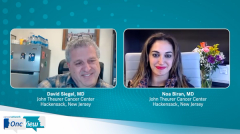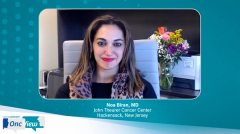
Allogeneic CAR T-Cell Therapy and Other Technology Advances in Multiple Myeloma
Myeloma experts give an overview of allogeneic CAR T-cell therapy and other technology advances in MM.
Episodes in this series

Transcript:
Noa Biran, MD: It’s really exciting, all the CAR [chimeric antigen receptor]T-cell therapies in development with novel targets, such as allogeneic CAR T cells and other targets such as GPRC5D. I think you also mentioned a light chain CAR T cell.
David Siegel, MD: You should explain what an allogeneic CAR T cell is.
Noa Biran, MD: Basically, you are using donor CAR T cells where you have a much more robust T-cell phenotype, because in patients with myeloma—especially those who’ve been heavily pretreated—you’ve depleted your healthy peripheral T-cell pool by the time you are doing apheresis on those CAR T cells. You have the opportunity with allogeneic CAR T cells to make these cells based on healthy, non-myeloma–affected T cells that can both attack the myeloma and perhaps stimulate some graft-vs-host–like effects, where you have cells-vs-tumor effect. The idea is that they can sustain much more durable remissions and that the T cells can persist much longer.
David Siegel, MD: This kind of stuff is in its infancy, allogeneic. To have a donor and be able to manufacture large numbers of cells that can then be used for a whole series of patients decreases the cost, decreases the turnaround time, and allows you to do engineering that would be prohibitive in terms of both time and cost that may improve some of the characteristics of these cells. This is in its very infancy. Again, the number of platforms that are being developed is enormous. Then we have other technological things we’re doing to improve the technology, not necessarily improve the targets, and we can talk about other targets, too. But there are toxicities that are problematic. These cells cause a lot of inflammation when they’re out there killing. People will have heard the term CRS, cytokine release syndrome, and neurotoxicity associated with those things. But all kinds of tricks are being developed to try to avoid some of these things.
There are CAR T cells that can be generated, either allogeneic or from the patient themselves, in which the target isn’t the cancer cell, it is a manufactured target. But you can then have that manufactured target bind to the cancer cell and go after that target itself. It sounds complicated, but you can take an antibody that sticks to the outside of a cancer cell and engineer it so it has a unique target that is part of that antibody, and then take a CAR T cell that targets that unique antigen. Then that same CAR T cell can be used to treat any cancer. Or you can use a combination of targeting antibodies to bind to the cancer cell, and then the CAR T cell can pick and choose which one it wants to bind to. The technologies are tremendous and will evolve very quickly.
In terms of other targets, myeloma is unique in that it is an antibody-producing cell, and each antibody is unique. You can even target the individual patient’s cancer because it makes a target that only that cancer makes. Right now, that’s prohibitive; you can’t do it. It takes too much time to raise the product. But technology is changing. We can synthesize some of these things in the laboratory. Ten years from now, we’ll be able to do things that are incomprehensible today.
Noa Biran, MD: It’s super exciting.
Transcript edited for clarity.
Newsletter
Stay up to date on recent advances in the multidisciplinary approach to cancer.



















































































